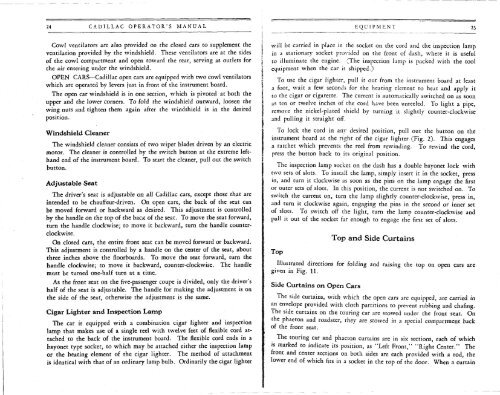1928 Cadillac - GM Heritage Center
1928 Cadillac - GM Heritage Center
1928 Cadillac - GM Heritage Center
Create successful ePaper yourself
Turn your PDF publications into a flip-book with our unique Google optimized e-Paper software.
24 CADILLAC OPERATOR'S MANUAL<br />
EQUIPMENT 25<br />
Cowl ventilators are also provided on the closed cars to supplement the<br />
ventilation provided by the windshield. These ventilators are at the sides<br />
of the cowl compartment and open toward the rear, serving as outlets for<br />
the air entering under the windshield.<br />
OPEN CARS—<strong>Cadillac</strong> open cars are equipped with two cowl ventilators<br />
which are operated by levers just in front of the instrument board.<br />
The open car windshield is in one section, which is pivoted at both the<br />
upper and the lower corners. To fold the windshield outward, loosen the<br />
wing nuts and tighten them again after the windshield is in the desired<br />
position.<br />
Windshield Cleaner<br />
The windshield cleaner consists of two wiper blades driven by an electric<br />
motor. The cleaner is controlled by the switch button at the extreme lefthand<br />
end of the instrument board. To start the cleaner, pull out the switch<br />
button.<br />
Adjustable Seat<br />
The driver's seat is adjustable on all <strong>Cadillac</strong> cars, except those that are<br />
intended to be chauffeur-driven. On open cars, the back of the seat can<br />
be moved forward or backward as desired. This adjustment is controlled<br />
by the handle on the top of the bacjc of the seat. To move the seat forward,<br />
turn the handle clockwise; to move it backward, turn the handle counterclockwise.<br />
On closed cars, the entire front seat can be moved forward or backward.<br />
This adjustment is controlled by a handle on the center of the seat, about<br />
three inches above the floorboards. To move the seat forward, turn the<br />
handle clockwise; to move it backward, counter-clockwise. The handle<br />
must be turned one-half turn at a time.<br />
As the front seat on the five-passenger coupe is divided, only the driver's<br />
half of the seat is adjustable. The handle for making the adjustment is on<br />
the side of the seat, otherwise the adjustment is the same.<br />
Cigar Lighter and Inspection Lamp<br />
The car is equipped with a combination cigar lighter and inspection<br />
lamp that makes use of a single reel with twelve feet of flexible cord attached<br />
to the back of the instrument board. The flexible cord ends in a<br />
bayonet type socket, to which may be attached either the inspection lamp<br />
or the heating element of the cigar lighter. The method of attachment<br />
is identical with that of an ordinary lamp bulb. Ordinarily the cigar lighter<br />
will be carried in place in the socket on the cord and the inspection lamp<br />
in a stationary socket provided on the front of dash, where it is useful<br />
to illuminate the engine. (The inspection lamp is packed with the tool<br />
equipment when the car is shipped.)<br />
To use the cigar lighter, pull it out from the instrument board at least<br />
a foot, wait a few seconds for the heating element to heat and apply it<br />
to the cigar or cigarette. The current is automatically switched on as soon<br />
as ten or twelve inches of the cord have been unreeled. To light a pipe,<br />
remove the nickel-plated shield by turning it slightly counter-clockwise<br />
and pulling it straight oft'.<br />
To lock the cord in any desired position, pull out the button on the<br />
instrument board at the right of the cigar lighter (Fig. 2). This engages<br />
a ratchet which prevents the reel from rewinding. To rewind the cord,<br />
press the button back to its original position.<br />
The inspection lamp socket on the dash has a double bayonet lock with<br />
two sets of slots. To install the lamp, simply insert it in the socket, press<br />
in, and turn it clockwise as soon as the pins on the lamp engage the first<br />
or outer sets of slots. In this position, the current is not switched on. To<br />
switch the current on, turn the lamp slightly counter-clockwise, press in,<br />
and turn it clockwise again, engaging the pins in the second or inner set<br />
of slots. To switch off the light, turn the lamp counter-clockwise and<br />
pull it out of the socket far enough to engage the first set of slots.<br />
Top<br />
Top and Side Curtains<br />
Illustrated directions for folding and raising the top on open cars are<br />
given in Fig. 11.<br />
Side Curtains on Open Cars<br />
The side curtains, with which the open cars are equipped, are carried in<br />
an envelope provided with cloth partitions to prevent rubbing and chafing.<br />
The side curtains on the touring car are stowed under the front seat. On<br />
the phaeton and roadster, they are stowed in a special compartment back<br />
of the front seat.<br />
The touring car and phaeton curtains are in six sections, each of which<br />
is marked to indicate its position, as "Left Front," "Right <strong>Center</strong>." The<br />
front and center sections on both sides are each provided with a rod, the<br />
lower end of which fits in a socket in the top of the door. When a curtain
















